The story of Dachau, as told to touristsEntrance to the Dachau Memorial Site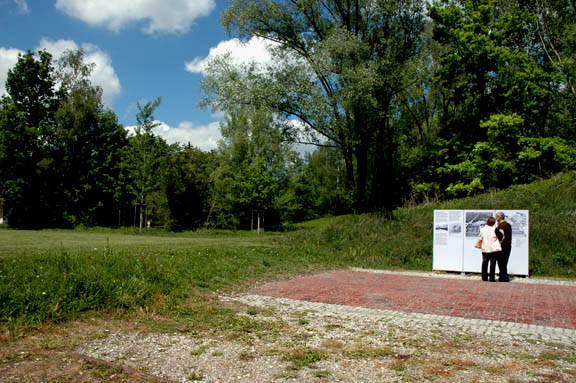 In 2005, the entrance into the Dachau Memorial site was changed so that visitors can now see a section of the brick path on which the prisoners walked as they neared the Arbeit Macht Frei gate into the prison camp. The photo above shows the brick path and the grass covering the rubble of the factory buildings that were torn down after American troops took over the SS training camp and garrison next door to the concentration camp. A new gravel path, which leads from the bus stop to the Arbeit Macht Frei gate, was constructed in 2005 on the south side of the Dachau complex, which includes the former concentration camp and what is left of the former SS Army Garrison and Training Center for concentration camp administrators, which the Dachau tour guides refer to as a "school of violence" or a "school of terror." The entrance into the Dachau Memorial Site was changed again when a new Visitor's Center was completed. New signs which tell the story of Dachau were added. Visitors can now see a few of the buildings inside the former SS garrison, including the Administration building which is the white building trimmed in yellow on the right in the photo below. When I visited in 2007, I was told that this building was the Commandant's house, but I have since learned that the house was torn down in 1987. 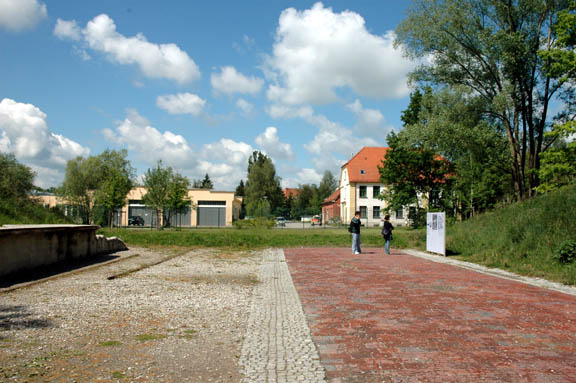 The brick path, shown in the photo above, was originally lined on both sides by a row of poplar trees. On the left side of the road, as you are looking into the SS training camp, there were formerly factories where the prisoners worked, and on the right side was an open field with a view of the barracks inside the concentration camp. Most visitors assume that the tracks on the left side of the photo above were railroad tracks on which trains loaded with prisoners arrived at the camp. These tracks were actually narrow gauge tracks used to transport material to and from the factories; the prisoners had to walk 3 kilometers to the camp from the railroad station in the town of Dachau. There are now 12 posters along the route from the station to the camp which tell visitors what happened as the prisoners walked through the town. Dachau was not turned into a Memorial Site until 1965. A visitor who saw the former Dachau concentrtion camp in 1964 wrote this on his blog: One evening I asked what I shouldn't miss when in Munich. More than one fellow traveler told me to make sure I visited Dachau, which was not far to the north. The next morning I made my way to the Autobahn and hitchhiked north towards the infamous destination. Drivers who picked me up would ask where I was going. When I replied "Dachau", the response was uniform; the conversation quieted to silence. In retrospect, the response shifted from awkward embarrassment to naked shame. I had to walk the last 2 or 3 kilometers to the entrance, as it was far away from any settlement. There was no commerce or residence in the area. The day was very gray, and it was as if the whole countryside was sterile. As I approached, there was a very long border of high wire fence. Walking through the entrance I found no one in attendance. I moved in turn through all the buildings and the displays. I never found a soul the entire day, at least none that were living. The dead were extremely prominent. I recollect photos of bones covered by skin, of "scientific" experimentation by hypothermia, of long, unheated wooden buildings (still standing at the time) where the inmates slept and became infected with lice and typhus.
The photo below shows the "very long border of high wire fence," which the visitor to Dachau saw in 1964. 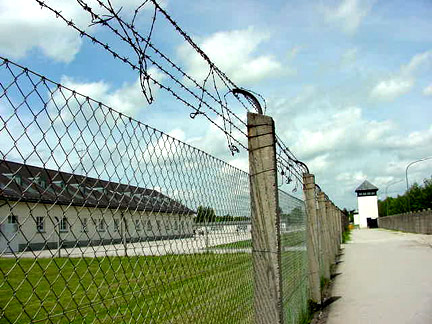 Eight hundred thousand tourists now visit the former Dachau concentration camp each year. After their pilgrimage to Dachau, there are two favorite words that visitors typically use to describe their experience: "sobering" and "moving." The typical tourist is a young student on a tour of Europe who has just arrived in Munich the day before and has spent the previous night visiting Bavaria's number one attraction - the Hofbräuhaus. Then it's on to the number two attraction - Dachau. The third big attraction in Bavaria is King Lugwig's castle, Neuschwanstein, which is next on the list after Dachau has been checked off. Dachau is a picturesque town, located 18 kilometers north of Munich; the town can be reached by a short train ride from Munich on the S-Bahn #2 line going towards Petershausen. From the Dachau station, tourists use their train ticket to take bus #726 or #724 to the former Dachau concentration camp which is now a Memorial Site. 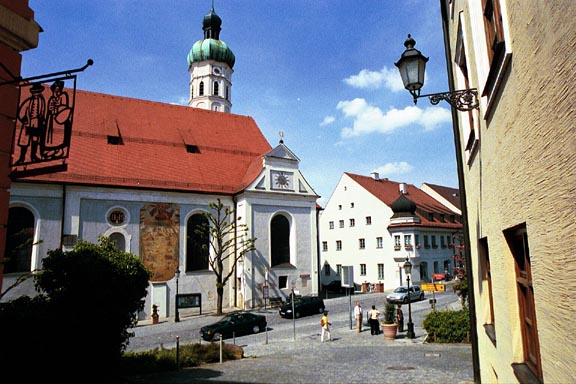 Few visitors bother to tour the town, which is shown in the photo above. Those who do visit the town are still angry with the townspeople: One tourist wrote this about the town of Dachau on her blog: I felt so many emotions today as I rode into town. I kept looking around at all the shops and beauty parlors and got angry. Why didn't they burn this place to the ground and salt the earth?? Didn't people know what went on here? I found out inside that when Dachau was liberated, the Americans marched the citizens of Dachau through to look at the piles of dead bodies and the living arrangements to see just what they had either been ignoring or were honestly unaware of. The tour guides like to tell visitors about the day that German citizens from the town of Dachau were brought to the camp to see what they had "allowed to happen in their town." The citizens of the town were shown the gas chambers and told all about the death factory at Dachau, which they claimed they knew nothing about, even though people in the town worked in the factories at Dachau and prisoners from the camp were sent to work in the town at 12 different locations including a large meat processing plant. American visitors are particularly impressed when they are told that the American soldiers forced the Germans to look at the dead bodies of the prisoners that had allegedly been gassed. The following quote is from A blogger's account of a visit to Dachau: The only lighthearted moment of the whole day came when we found out what the U.S. forces did when they liberated Dachau. They forced the people who lived in Dachau to come to the camp, and view what was happing in the Dachau people's back yard. There were still dead bodies piled up that had not been burned. The camp had run out of coal. That is such an American thing to do. Look, you f***ed up. This is what it looks like. You see it. See it? Don't ever do this again. The worst thing about Dachau is that it shows how much worse the genocide was there. This is not to say that I don't think that the situations in Serbia or Darfur are good, but they aren't systematic. With the Nazis, it was not blind hatred and rage fueling rash slaughters of towns of people. It was a systematic destruction of a race. Propaganda and camps were involved. It was organized, and that makes it so much colder to think of. At the Dachau Memorial Site entrance, visitors can rent a device for recorded information, which is available for self-guided tours. The recording cautions visitors that Holocaust denial is a crime in Germany and that the Nazi salute is forbidden. Most visitors to Dachau arrive in groups and are escorted by a tour guide, who instructs them in the horrors suffered by the Dachau prisoners. The following quote is from a blog written by a visitor, whose tour guide, Steven, had researched Dachau for 15 years: This was the prototype camp. It was here that the men who invented the idea of concentration camp and death camp turned their ideas to reality. They had a lust for cruelty. Even long after Hitler demanded an end to killing - the prisoners being needed for labor - the killing continued. And not in gas chambers. Dachau had them, but did not use them. The killing was done for sport. Guards could use any excuse they could invent to shoot someone. The most sickening thing was when a guard would take a prisoner to the camp boundary and throw their hat over the border. Should the prisoner fetch, they would be shot dead. Should they not fetch, they would be beaten either until dead, or until they would crawl battered and bloodied over the border hoping to be shot dead. Visitors leave with the idea that the SS soldiers on the Dachau staff had no rules to govern their behavior and that there was a total lack of discipline for the SS men. They are not told about Dr. Georg Konrad Morgen, the SS judge who investigated all the camps and prosecuted 200 cases of murder and mistreatment of the prisoners. Five Commandants were arrested and two were executed after being convicted in Morgan's court, but Martin Gottfried Weiss, the commandant of Dachau, was given a good report by the prisoners. 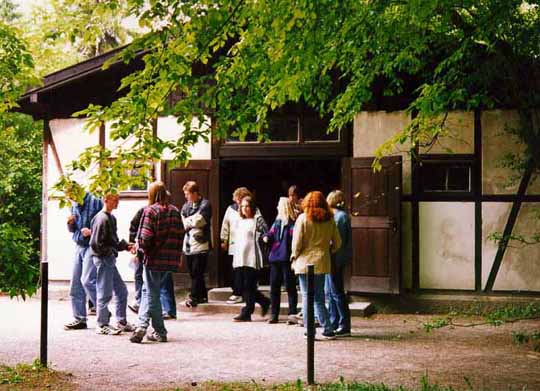 Young German students, who are required to take a tour of a concentration camp, also arrive in groups, escorted by their teachers. They look very subdued as they listen to their teacher's shameful account of the crimes committed by their great-grandparents. Most students are apprehensive about visiting Dachau. They have studied the Holocaust in elementary school, and they arrive with pre-conceived notions. They are not disappointed; they learn that the Dachau concentration camp was even worse than they thought it was. Visiting the former camp gives them a feeling of satisfaction, knowing that they have seen the place where the world's worst crimes were committed. One visitor wrote the following on this blog: Although it was a sad place it felt like something that had to be done and I am very glad I went. Like I said, it makes you really think about things like that and think how lucky you really are, it raises the hair on my arms just thinking that I set foot in a place where approximately 206,200 people were murdered without a second thought. It was definitely a good place to see. Actually, there were 206,206 prisoners registered at Dachau during its 12 year history, and there were a few more than 6 people who were not murdered. After a trip to Europe, which included a visit to Dachau, Naomi Spencer wrote this in an article for the Spring Arbor University newspaper: On a rainy day, we go to Dachau concentration camp. While there, we run our hands across wooden bunk beds where emaciated bodies were stacked like cards. We walk through execution chambers where poison gasses streaming from showerheads ended the lives of human beings crowded like animals in cages; we see the nail marks on the walls. We see grass matted down from rivers of blood flowing out from human ovens. The walls of the gas chamber are made of glazed brick and there were no fingernail scratches, as of May 2007, but they might have been added since then. The grass and flowers that formerly surrounded the building with the "human ovens" has been replaced with a field of coarse gravel but visitors see what they want to see, not what is there. The following quote is from A blogger's account of her Dachau tour: The tour began outside the main gate. The gravel walkway is the same path that the prisoners were forced to walk as they were brought into the camp. She explained the role of Dachau and how it began. She also gave the history of how the village of Dachau was kept in the dark about what was really going on. Of course, near the end with liberation rapidly approaching, they were killing people as quickly as possible and the on site crematorium was not sufficient. So, they burned bodies day and night, and still had to create several mass graves in the surrounding area. After the detailed depiction, we all headed back through the gate and soberly made our way to the camp prison, the most feared building in the camp. This was where some of the most horrific torture took place. It was also where all of the priests were placed. They were forced into tiny cells, or worse, the standing cells. They were beaten, tortured, and often were brutally murdered. Sometimes, the guards simply gave the prisoner a length of rope and left them to kill themselves. If a guard was particularly blood thirsty, then they would tie their hands behind their back, then hang them from a pole for at least an hour. This dislocated the prisoners shoulders and, because they were worth nothing at all if they could not work, they were shot in the back of the neck only after the guards had had their fill. They were shot in the back of the neck because people survive being shot in the head, but not when their cv spine has been severed. Quite a few people, men and women, were crying at this point. I was worried about taking a tour, but my concerns were unwarranted. Everyone was respectful. The Nazis kept meticulous records at the concentration camps, but not meticulous enough. According to a report made by the International Tracing Service of the Red Cross at Arolsen, Germany in 1977, there were 31,951 recorded deaths at the main Dachau camp during the 12 years that the camp was in existence. Today the staff at the Memorial Site tells visitors that 41,566 is a conservative estimate of the number of deaths at Dachau. A visitor wrote on her blog in July 2009 what a tour guide named Alan told a student group about the number of deaths: Upon arrival, our guide, Alan, gave us the background history of the camp. He told us that the numbers of people who died there were inaccurate, because Jews, Gypsies and old or weak prisoners were not counted in the death toll because they were not considered people. Also, the majority of bodies in the mass graves were not identifiable. The "mass graves" are on a hill called Leitenberg, a few miles from the Dachau camp. Unidentified bodies found in the camp by the American liberators are buried there. At the end of the gravel entrance path, visitors turn to the right and enter through the original gate into the former camp, shown in the photo below. The railroad tracks on the right hand side of the photo below were narrow gauge tracks used for carrying material to the factories. The prisoners arrived at the Dachau train station and walked to the camp. 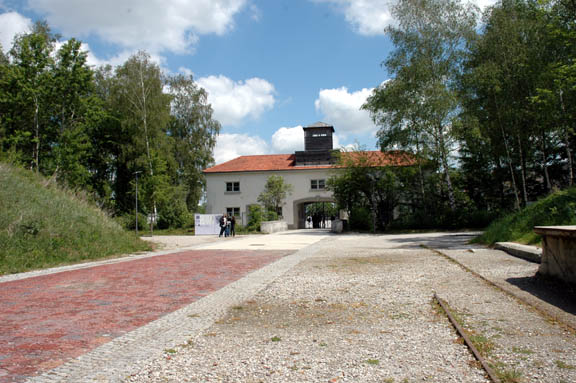 The Dachau concentration camp was originally set up in an abandoned factory, but in 1936, the camp was redesigned and the gate house shown in the photo above was built. The old factory buildings were gradually torn down and replaced by wooden barracks. The new camp was completed in 1938. 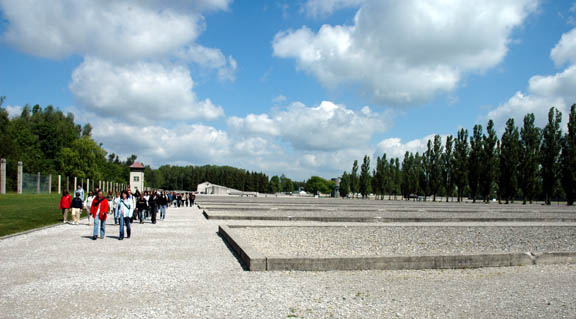 Visitors marvel at the concrete-lined gravel beds, shown in the photo above, that denote the location of the former barracks and the two rows of poplar trees which line the Dachau camp road. The original trees, planted by the prisoners in 1938, were removed in 1948 when Dachau was turned into a refugee camp; the present trees were planted in the 1980s and some have been replaced since then. A tour guide named Kevin told the visitor who wrote this blog that: The trees were added in the late 1930's when the Red Cross came to investigate the camp and make sure prisoners weren't being deprived of their human rights. The Nazi's knew the investigation was going to happen, so they did everything they could to make the camp pass the test it was all an illusion though. Actually, the famous Verschönerung, the beautification program in which the Nazis cleaned up a camp, in preparation for a visit by two Swiss delegates of the International Red Cross and two representatives of the government of Denmark, took place on June 23, 1944 at Theresienstadt. 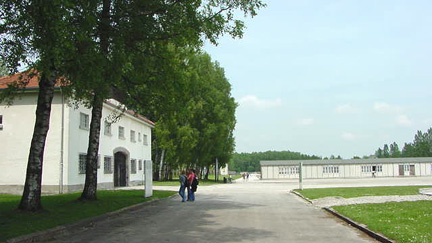 Shown in the photo above are two reconstructed barracks where visitors can see how the prisoners lived. Originally, there were flower beds at both ends of each barrack. The area around the crematorium was originally landscaped like a garden and there were even fresh flowers in a vase in the undressing room for the gas chamber when the American liberators arrived. The vast field of coarse gravel, which visitors see when they enter the camp, was added when the Memorial Site was constructed. This space was originally broken up by paved areas and paths lined with flower beds. The photo below, which was taken in the Dachau Museum shows a locker with clothes and personal items inside. In the early days of the camp, each prisoner had a locker like this. 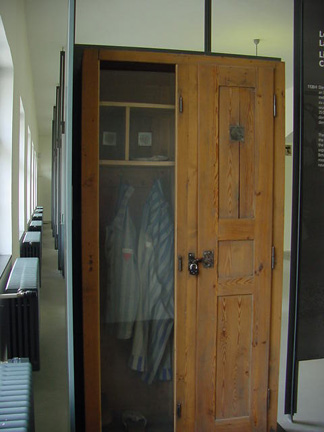 It was only in the last days of the war that the Dachau camp became seriously over crowded when prisoners were brought from other camps that had been abandoned. Some tour guides tell visitors that incoming prisoners at Dachau were tattooed with a number on their arm, although this was only done at Auschwitz. Arbeit Macht Frei gateInternational Monument & Unknown PrisonerDachau MemorialsGas chamberDisinfection Chambers & OvensDachau Museum & BunkerRefugee Camp at DachauBack to Dachau Concentration CampBack to Table of ContentsHomeThis page was last updated on January 24, 2010 |